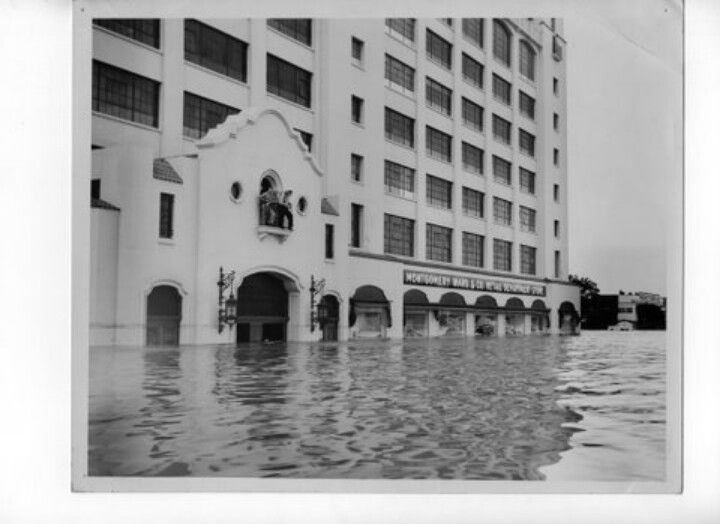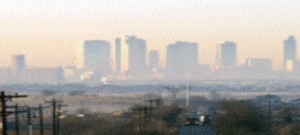Posts Tagged ‘Fort Worth’
Blue Stain Removal: Chesapeake’s Julie Wilson Leaves Cowtown Blue Zones Project
 Via the Fort Worth Star-Telegram, it seems the city finally wised up and decided it was not a good match to have the most high-profile promoter of urban gas drilling in Cowtown be the spokesperson for a new "healthy lifestyle" initiative.
Via the Fort Worth Star-Telegram, it seems the city finally wised up and decided it was not a good match to have the most high-profile promoter of urban gas drilling in Cowtown be the spokesperson for a new "healthy lifestyle" initiative.
Last Friday, Healthways announced that former Chesapeake top executive and all-around shill for everything-is wonderful-about drilling, Julie Wilson, had resigned her post as VP for the Fort Worth Blue Zones Project that seeks to promote a dialog about healthier choices for residents. Unfortunately it arrives about eight years too late to initiate a discussion about the wisdom of putting large toxic air polluters next to homes, schools, and parks.
Wilson's appointment to the Zones Project had raised eyebrows and objections even among a mostly quiescent Fort Worth population that had been among the first victims of the fracking boom in the late "Oughts." As in, we ought to have thought about this some more. Blue Zones got sizable blowback over her hiring, and it followed them wherever they showed up for one of their many community meetings, making for uncomfortable distractions to their more mainstream agenda concerning people's smoking, eating and exercise habits.
Wilson's resignation is one more sign of how far Chesapeake's star has fallen in Fort Worth. It's former corporate headquarters on the banks of the Trinity is now owned by Pier 1. Most of its Barnett Shale holdings have been auctioned off for needed cash. Aubrey McClendon, its founder and CEO had to resign last year after a stock scandal. The city and other entities are suing the company for royalties they think they were cheated.
But like the high-watermark from the 1949 flood that lasted for decades on the old Montgomery Wards' warehouse on 7th street, the pollution from its former facilities and stains on Ft. Worth's civic infrastructure from Chesapeake's invasion remain to remind everyone just how badly Fort Worth was rolled by the company.
New UNT Study-In-Progress Links Gas Pollution to Persistent DFW Smog
 This is why it's important for citizens to have real scientific horsepower.
This is why it's important for citizens to have real scientific horsepower.
DFW has a smog problem. It's not as bad as it used to be, but it's still at unsafe and illegal levels. And for the last four or five years, the air quality progress that should have been made has been stymied. Despite almost all large sources of smog-producing pollution being reduced in volume, our running average for ozone is actually a part per billion higher than it was in 2009.
Many local activists believe this lack of progress is due to the huge volumes of smog-producing air pollution being generated by the thousands of individual natural gas sites throughout the DFW region itself, as well as upwind gas and oil plays. In 2012, a Houston-based think tank released a report showing how a single gas flare or compressor could significantly impact downwind smog levels for up to 5 mile or more. Industry and the Texas Commission on Environmental Quality say no, gas sources are not significant contributors to DFW smog. In fact, during this current round of planning, the state has gone out of its way to downplay the impact of gas pollution, including rolling back previous emission inventories and inventing new ways to estimates emissions from large facilities like compressor stations.
Into this debate steps a UNT graduate student offering a simple and eloquent scientific analysis that uses the state's own data on smog to indict the gas industry for its chronic persistence in DFW – especially in the western part of he Metromess, where Barnett Shale production is concentrated.
On Monday night Denton Record-Chronicle reporter Peggy Heinkel-Wolfe gave a summary of a presentation on local air quality she'd sat through that day at UNT:
"Graduate student Mahdi Ahmadi, working with his advisor, Dr. Kuruvilla John, downloaded the ozone air monitoring data from the Texas Commission on Environmental Quality back to 1997, a total of more than 6.5 million data points, he said, and has been studying it for the past four months.
Ahmadi wanted to explore a basic question underlying a graphic frequently distributed by the TCEQ that shows gas wells going up in DFW as ozone goes down, which suggests in a not-very-scientific-at-all way, that the increasing number of gas wells is having no effect on the ozone.
Ahmadi adjusted for meteorological conditions to determine how much ozone DFW people are making and where. Such adjustments have been explored by others to understand better the parts of ozone-making we can control, because we can’t control the weather. He used an advanced statistical method on the data, called the Kolmogorov-Zurbenko filter, to separate the effects of atmospheric parameters from human activities.
According to the results, the air monitoring sites surrounded by oil and gas production activities, generally on the west side of DFW, show worse long-term trends in ozone reduction than those located farther from wells on the east side of DFW.
His spatial analysis of the data showed that ozone distribution has been disproportionally changed and appears linked to production activities, perhaps an explanation why residents on the western side of DFW are seeing more locally produced ozone, particularly since 2008.
Ahmadi's results are not definitive, and the paper he's writing is still a work-in-progress. But he's asking the right questions, and challenging the right unproven assumptions. He's at least put forth an hypothesis and is trying to prove or disprove it. He's using science. TCEQ's approach is all faith-based.
Anything that takes the focus off vehicle pollution is anathema to Austin and many local officials who want to pretend that industrial sources of air pollution don't impact the DFW region enough to make a difference so they don't have to regulate them. If there's a guiding principle to TCEQ's approach to this new clean air plan, due in July 2015, it's to avoid any excuse for new regulations while Rick Perry is running for President. The agency isn't interested in doing any kind of science that might challenge that perspective – no matter how persuasive. After all, you're talking about a group that doesn't believe smog is bad for you. TCEQ doesn't want to know the truth. It can't handle the truth. It's got an ideology and it's stickin' to it.
So it's up to young lowly graduate students from state universities armed only with a healthy sense of scientific curiosity to step up and start suggesting that the Emperor's computer model has no clothes, and offering up alternative scenarios to explain why DFW air quality is stuck in neutral. It turns out, just doing straight-up classroom science is enough to threaten the fragile House of Computer Cards with which the state's air plan is being built.
Perhaps equally as ominous for the success fo any new clean air plan is Ahmadi's discovery that ozone levels in DFW have been during the winter time, or "off-ozone-season." There could be a new normal, higher background level of smog affecting public health almost year round.
Mahdi Ahmadi's study is just one of the many that need to be done to construct an honest clean air plan for DFW, but it shows you what a curious mind and some computing power can do. Citizens can't trust the state to do the basic science necessary as long as the current cast of characters is running the show in Austin. EPA won't step in and stop the farce as long as TCEQ can make things work out on paper. If the scientific method is going to get used to build a better DFW clean air plan, it's going to have to be citizens who apply it.
“Don’t let the Door Hit You…”
 Sharon's rumors turn out to be true. Chesapeake's VP Julie Wilson is leaving the company as of June 14th. Her mission to subjugate Cowtown to all things gas now accomplished, she plans to resume her "consulting" business. She's going to be replaced by a guy from Oklahoma City who'll visit Fort Worth "a couple of days each week." Oh, that one hurts.
Sharon's rumors turn out to be true. Chesapeake's VP Julie Wilson is leaving the company as of June 14th. Her mission to subjugate Cowtown to all things gas now accomplished, she plans to resume her "consulting" business. She's going to be replaced by a guy from Oklahoma City who'll visit Fort Worth "a couple of days each week." Oh, that one hurts.
Once Fort Worth was the capital of a mighty Chesapeake Nation. And Julie was its (Ice) queen, reigning over things with all the skill of the advertising executive she really is. But the company has hit a rough patch of late, and nothing says the empire is crumbling more than this announcement. Well, maybe abandoning their capital in downtown Fort Worth.
As we mentioned below, Fort Worth residents may be coming out of their gas-induced daze at the same time the major gas benefactor for the town loses its mojo. But Wilson and crew did a lot of damage and it'll take a very long time for Fort Worth to recover.
A Fort Worth Gas Backlash at The Voting Booth?
 For the last couple of years Dallas has gotten all the headlines over gas permit fights. It's because the Barnett Shale play took its time to roll eastward while evidence was mounting about the adverse effects of fracking. There was still a large precedent to be set when the play met the new evidence in Dallas. Citizens groups with professional staffs, like Downwinders, made a stand over a new Big D drilling ordinance (still) in progress.
For the last couple of years Dallas has gotten all the headlines over gas permit fights. It's because the Barnett Shale play took its time to roll eastward while evidence was mounting about the adverse effects of fracking. There was still a large precedent to be set when the play met the new evidence in Dallas. Citizens groups with professional staffs, like Downwinders, made a stand over a new Big D drilling ordinance (still) in progress.
But whereas Dallas has been the reluctant and controversial wallflower to the gas suitors, Fort Worth has been the region's floozie, stumbling over itself to offer up all of its goodies to the highest bidder. In Cowtown, no cultural, political, or social institution has been left unaffected by the smell of gas money. Officials who were preaching about clean air and regional responsibility in the 1990's took the money and ran…right over to Chesapeake HQ. Now, fights over gas permits there are considered a kind of fifth column exercise by the rest of us. But of course, that's the way most people view being an environmentalist in Texas.
However, this last election cycle saw some signs of Fort Worth waking-up from its ten-year party. This Star-Telegram article points to opposition to a large compressor station as being a factor in the District 5 City Council run-off race there between incumbent Frank Moss and challenger Gyna Bivens. Bivens actually garnered more votes in the general election back in May.
"Bivens, who lives in Ramey Place near Dunbar High School and won her precinct by a wide margin, put up her strongest results in neighborhoods north of Interstate 30 and east of Loop 820. Those neighborhoods – new to the district in a redraw of council maps – are seeing new development and fighting attempts by the natural gas industry to place gas compressors on agriculturally zoned land in the bucolic area."
Coming out of this same neighborhood and leading the fight against that compressor is recent Tarrant Regional Water District winner Mary Kelleher, who was the only one of three challengers to win against entrenched incumbents of this usually staid entity.
As far as we can tell, these are the first successful races to spotlight gas industry problems in Fort Worth. Considering the amount of wheeling and dealing over the last decade, surely they won't be the last.
